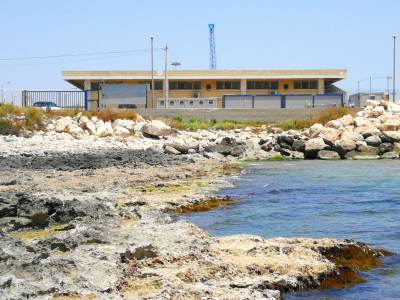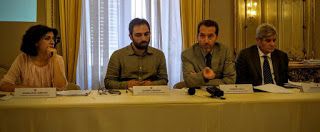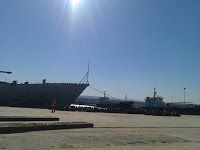A hotspot in Messina instead of Augusta–What is a hotspot and what are the differences to other first reception centers?
Source: Tempostretto
For three years now the city of Messina in Sicily is constantly occupied with the routine state of emergency of the reception of migrants. People arrive at the city pier on a daily basis, the former barracks of Bisconte remain active and, moreover, reception continues in the tent city of Pala Nebiolo, depending on the season in dust or in mud. Unaccompanied minors are accomodated in the Ahmed center. Taken together, the city has three reception centers, two of which are under ministerial aegis, while the third one is run by the city Messina.
Now, there have been news from Rome that might make Messina the scene for the newest developments in European migration policy: the building of a first reception center, a so-called hotspot. This is what an article by Vladimir Polchi in the daily newspaper “La Repubblica“ has revealed. It reports that the Italian Ministry of Interior „has decided“ to move the hotspot to Messina that originally was to be built in Augusta since the end of 2015. The realization of this project, however, has been stopped by the administration of Syracuse, because of alleged friction in the contracting.
What would be the consequences of opening a hotspot in Messina? Who believes this is only one of the many names for a governmental first reception center for refugees arriving on European territory is in the wrong. The realisation of a hotspot results in precise parameters stated in a document of the European Commission, the first of which requires the total militarization of the arrivals and of the designated center, supported by agents of various European agencies. The area around the hotspot up until the landing operations area becomes a so-called “vested area”. In this case, the proposals made on the regional round table on January 21, 2015 could be reconsidered, as the responsible authorities of the cities’ and province’s civil protection suggested the Magazzini Generali a suitable area to support landing operations. Police, however, disagreed with this based on security concerns.
In a document called “Hotspots – a concept for the regulation of extraordinary migration flows” the European Commission explains that a proposal has been made in the European agenda in May 2015 in order to „develop a new solution on the basis of hotspots for the support of the states primarily dealing with extremely strong pressure of migration at the external borders of the European Union.” The document refers to Italy and Greece as primarily affected countries.
The first difference to other ministerial reception concepts is the immediate involvement of other European agencies such as the EASO (European Asylum Support Office), or Europol (European Police Office), Frontex (European Agency for the operative cooperation on the external borders of the European Union), and Eurojust (Agency for judicial cooperation in the European Union). The employees of these agencies are sent out to register personal and biometrical data such as fingerprints. Subsequently, the EU employees are in charge of the debriefing of asylum seekers as well as their deportation if applicable.
Since April 2015, the Italian headquarters of Frontex are in Sicily, Catania. From here, the four harbors of Pozzallo, Porto Empedocle, Trapani and Lampedusa are coordinated, all of which were designated hotspots in a first draft of the European commission. These are the motives for the official determining of the centers: “In these places there are first reception centers where the hosting, identification and digital registration of up to 1,500 people are possible.”
Relocation is the new plan of action that lies in the project “hotspot.” After the identification procedures, the EU envisages that “the temporary relocation mechanisms” are executed to identify “people who are in clear need of international protection to send them to other EU member states where their application for asylum will be considered.” Yet herein lies the failure of this system: The policy of relocation of asylum seekers on the basis of constantly changing and never clearly defined quotas from border states such as Italy and Greece to other member states. “The relocation from Sicilian centers has failed completely,” the lawyer Vassallo Paleologo concludes in a report presented on February 25, 2016 by the organization LasciateClEntrare (lit. let us in). “In the last months of the past year, during which thousands of arrivals had taken place, the relocation of more than 200 asylum seekers towards other European countries couldn’t be managed, even though they undoubtedly belonged to the category ‚in clear need of protection’.“
This is only one of many problems monitoring organizations, local associations, and the civil society point out that have arisen since the opening of the first hotspot in Lampedusa. There are many notices coming in from migrants telling about forceful fingerprinting procedures and threats to be held longer if they don’t cooperate. Those who completely refuse to undergo identification procedures experience a so-called “delayed deportation”: They are literally put out on the street, without any help and a note that says that they have to leave the country in the course of 7 days, although they obviously do not have the means to do so.
This is not the first time that Messina falls victim to political attempts to solve matters of ministerial migration policy. Messina was considered suitable when, in 2013, the creation of three big hub-centers for migrants was planned, two of which on the peninsula and one in Sicily. This project, however, was given up later. The barracks of Bisconte were supposed to become a hub for 600 people after initial plans of the Italian Ministry of Interior.
Eleonora Corace
Translation: Annika Schadewaldt




